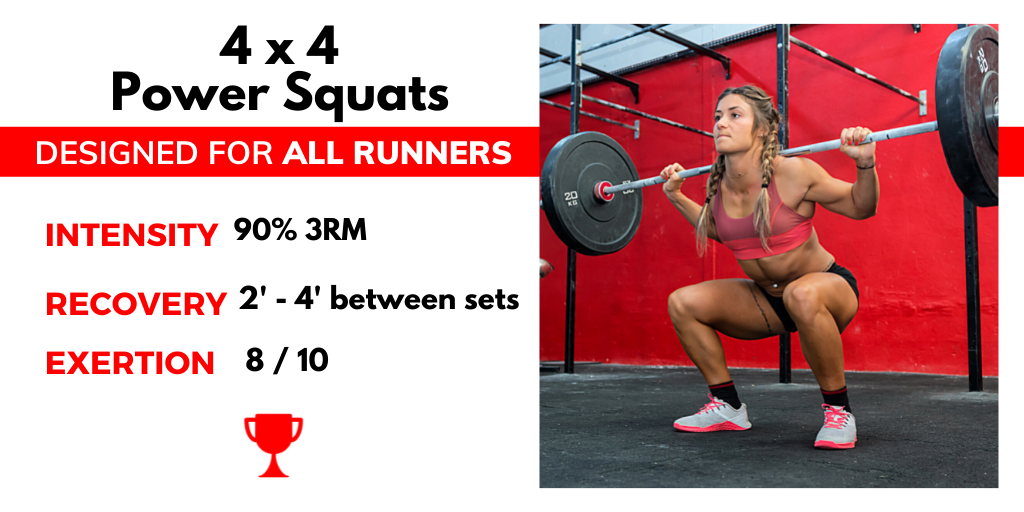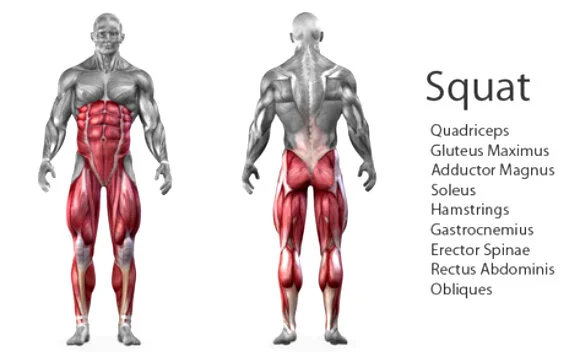4 x 4 Power Squats
4 x 4 Power Squats
Designed for ALL runners
Intensity
90% 3RM
Recovery
Full Recovery, 2’ - 4’ rest between sets
Exertion
8/10
Periodization
Specific Period
Context & Details
In training of runners there are two topics that spur great confusion and much debate:
Strength Training and Running Form
I saw this gap early on in my coaching career and dedicated over a decade to understanding strength training theory and best practices so I could successfully apply it to runners (I’m still working on understanding running form).
I sought Strength & Conditioning certifications from NSCA and USTFCCCA. Talked with hundreds of Sport Performance (S&C) coaches at the high school, college, professional levels. Bought books. Listened to podcasts. Watched YouTube videos. Went to clinics. Developed mentors, asking them question after question. Experimented on myself, on my runners. All until I finally grasped what strength training is really all about.
Simply, as I understand it, strength training — at its most fundamental level — is about developing, improving, and refining the brain’s connection with the body.
Whether it’s sensory feedback, force production, movement patterning, reactive mechanisms, posture, stability, mobility, etc. strength training is best thought of high-quality learning activities that seriously upgrades the brain, body, and their connection.
That’s it.
It’s not about getting big or bulky muscles. Or chasing crazy numbers in the gym that don’t correlate to performance on race day.
Strength training is a (highly effective) means of building a better athlete — one runners should embrace, not avoid.
WOTD Strength Training for Runner posts are meant to demystify strength training exercises so runners and coaches can confidently (and successfully) implement this vital type of training into their programs.
Both research and practice have proven strength training provides powerful performance upgrades in runners.
But most runners still avoid the gym.
Why?
There are many reasons, but I believe the main obstacle is the misguided (and fundamentally) wrong belief that lifting weights will cause runners to gain weight by bulking up their muscle mass.
Too many coaches and runners correlate gym work with the exaggerated muscle development of bodybuilders. But the fact is, it’s very difficult to gain muscle mass. And lucky for runners, there is enzyme signaling from endurance running which blunts or mutes the hypertrophic response of skeletal muscles from strength exercises.
Meaning, runners who do strength training won’t get “jacked” as characterized by excessive skeletal muscle enlargement. They will, however, get “shredded” — leaner body composition — as well as faster, stronger, and more injury resistant. All of which are highly desirable adaptions.
Runners I coach have been strength training since day 1 of my coaching career, and it’s a big reason why they’ve enjoyed more victories and better personal best marks than they thought possible.
If you want to get better results by learning more about strength training for runners, Join the Running Scholar Program for only $29 to get unlimited access to courses and real-world strength training workouts from training logs of high performance runners.
With that understanding in place, let’s look at today's workout of 4 x 4 Power Squats.
Squatting is a fundamental human movement pattern that involves many muscles in the body, mostly in the trunk and legs.
There is a lot of information about squats available. This article from Precision Nutrition is a concise, accurate primer on all things squat to get your bearings.
For runners, when adding weight to the squat movement pattern, I prefer to employ the Goblet Front Squat technique (video example here) to remove any compression on the spine.
Power squats for runners are aimed at developing the ability to generate high forces quickly in the hips. The goal is to move from the seated position to standing position as quick as possible while being challenged by a heavier load (weight).
With my runners, I ballpark weight used for a strength exercise at roughly 90% of their 3 rep max or what they feel is “pretty heavy” that day.
Since we’re not chasing numbers in the gym, we can be imprecise with the weight. Use a weight that is heavy enough to present a challenge as well something your runners have confidence they can lift. When strength sessions are performed (recovery day, in the morning, afternoons, after a hard running workout or a longer run) will also impact the readiness of the runner’s nervous system and the amount of weight optimal for them that day.
I’ve found four reps is a sweet spot for developing power in gym work. It’s enough reps to improve motor learning, coordination, and recruitment, but not too many that it overtaxes the nervous system.
When seeking to develop power, never lift to failure. In fact, it’s best to finish each set 2 - 4 reps away from the failure point.
Taking 2’ - 4’ minutes rest between each set allows the runner’s nervous system to fully recover so they can apply maximal effort on each rep.
One of my top rules for training runners (applied to gym work) is: don’t try to do the most work possible, try to get the most possible out of the work you do.
Keep gym exercises short, quick, producing high-forces, staying highly focused, with generous recovery periods.
The point of power squatting is for this work to transfer to race day, so the runner can run stronger, faster, and longer. The higher the quality of work in the gym, the higher degree of transfer to running will result.
Runners performing 4 x 4 Power Squats 2 - 3 times a week for 4 - 6 weeks will see a lot of positive adaptation. Namely, enhanced explosiveness when running fast, better “core” stability and leg strength on the run, plus a more developed nervous system which will enhance motor unit recruitment and help to deter excessive pace declines in the final stages of racing (provided the corresponding run training is adequate as well).
Runners new to power squatting and strength training, benefit most from this type of work on easier running days. Runners with strength training experience can perform gym work after harder runs or workouts and still derive benefit, provided there is 30+ minutes between the harder run and gym session, so some rest and nutritional replenishment can be had.
Get Better Results with The Running Scholar Program.
Join the Running Scholar Program for $29 to learn more about successful Strength Training for runners and get unlimited access to courses and training programs which include strength training programming for runners
3 Good Books on the benefits of Squatting and Strength Training
Squat Every Day by Matt Perryman
Science of Practice of Strength Training by Vladimir M. Zatsiorsky
Athletic Development by Vern Gambetta



